Bang Kachao, Samut Prakan, Thailand
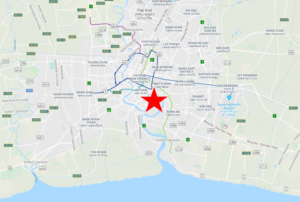
Selected as “Asia’s best urban oasis” in one survey, Bang Kachao is a peculiar anomaly: a floodplain forest directly across the river from downtown Bangkok. The rural community that occupies the fertile delta island subsists on a combination of agroforestry and tourism. It is also the largest wooded area on Thailand’s central plain and the best site for woodland birds in the Bangkok metropolitan area. Stork-billed Kingfisher and Vinous-breasted Starling are fairly common residents, and Black Baza and Black-naped Monarch are present in winter.
Orientation
Directions
Although it is centrally located near the heart of Bangkok, there are only two routes into Bang Kachao: by skiff from the port, or by road from the Phra Pradaeng district. For many visitors, arrival by skiff will be preferable for a handful of reasons, including the fact that it can be done via public transportation.
By Skiff from the Port. To reach Bang Kachao by public transportation, take the MRT Dark Blue rail line to the Queen Sirikit National Convention Center station, and walk 1.5 km south past the enormous Khlong Toei Market to the Khlong Toei Pier—in the midst of Bangkok’s central port facilities. It is also possible to drive to this point, a side-street off of Kasem Rat Road, and park just west of the Bangkok Port Customs Export Office.
Walking toward the Chao Phrya River, the small skiff dock will be straight ahead and easy to recognize, with signs indicating Bang Kachao. As you arrive at the dock, an attendant will direct you into one of the low-slung canoes for the quick five-minute trip across the river.
Upon reaching the other shore and debarking at the Raft House Pier, you will directed to the office to pay for the ferry service. In 2019, the round-trip price was 300 baht, and included the rental of a bicycle to get around Bang Kachao.
By Road. For those who have a car and prefer to drive across Bangkok, the only vehicular access to Bang Kachao is via Phetchahung Road, accessed via Suk Sawat Road in the Bang Phueng district of Samut Prakan.
Take Suk Sawat Road and exit onto the Industrial Ring Road, keep left and exit north onto Phrarachveriyapron Road. At the second intersection, turn right onto Song Tum Road.
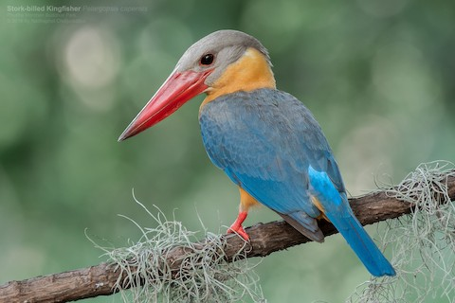
Bang Kachao supports the largest population of Stork-billed Kingfishers in the Bangkok area. © Natthaphat Chotjuckdikul
After 1 km, Song Tum reaches a T-junction with Phetchahung Road. Turning left onto Phetchahung Road soon takes you onto a bridge over a canal and into Bang Kachao. The areas of primary interest begin about 6 km beyond the bridge.

Birdfinding
Bang Kachao preserves a rural environment within a major metropolitan area. Much of the area is interesting to explore, including several points of cultural interest, but two areas are more extensively forested than the rest, and reliably provide good opportunities for bird observation: (1) Sri Nakhon Khuean Khan Park, and (2) the flooded palm forest at the northwestern tip.
Sri Nakhon Khuean Khan Park. First-time visitors should probably plan on spending most of their quality time in the park, the entrance to which is about 2 km south of the Raft House Pier. A large pond dominates the space, and the main trail through the park mostly traces its perimeter, with a detour into a small tract of somewhat intact forest.
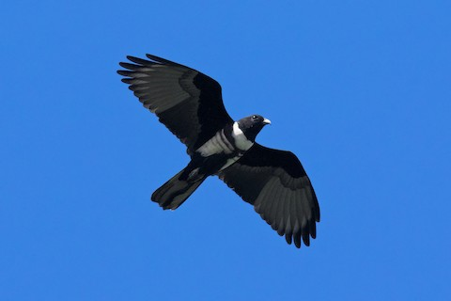
The elegant Black Baza is an uncommon but regular winter visitor to Bang Kachao. © Ayuwat Jearwattanakanok
The forest section of the trail includes a bird observation tower with a platform at canopy level—as with such towers in general, this one is hit-or-miss, depending on whether birds happen to be in that particular area.
Some of the birds often seen in the park that are uncommon or absent elsewhere in Bangkok, include: Black Baza, Shikra, Brahminy Kite, Green-billed Malkoha, Stork-billed Kingfisher, Lineated Barbet, Laced Woodpecker, Greater Racket-tailed Drongo, Black-naped Monarch, Gray-headed Canary-Flycatcher, Dark-necked Tailorbird, Pale-legged Leaf-Warbler, and Black-collared and Vinous-breasted Starlings. The starlings can often be found feeding on the ground near the park entrance.
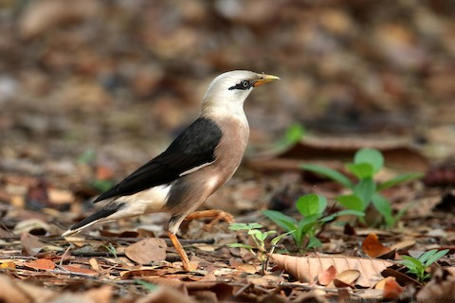
Vinous-breasted Starling at Sri Nakhon Khuean Khan Park in Bang Kachao. © B.C. Heng
During migration, many other species occur regularly, most notably cuckoos in March and April, with at least seven species that are found more often at Bang Kachao than at other sites in Bangkok: Chestnut-winged, Asian Emerald, Indian, Himalayan, Square-tailed Drongo-Cuckoo, and both Large and Hodgson’s Hawk-Cuckoos.
Flooded Palm Forest. Closer to the Raft House Pier, accessed by a small network of elevated walkways to the southwest of it, is a neighborhood of widely spaced houses and agroforestry plots. The westernmost point accessible by these paths is an intact palm forest that the Chao Phrya River inundates twice daily. This is an especially good location for Striated Heron and Stork-billed Kingfisher, along with the commoner large kingfishers: Collared and Black-capped.
Most of the same birds found at the park are also likely to occur in the agroforestry area and flood zone.
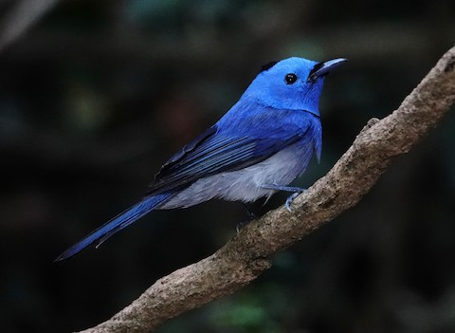
Black-naped Monarch is a fairly common winter visitor to Bang Kachao. © David Diller
Notes
When to Visit
Bang Kachao can be productive at any time of year, but diversity peaks in migration periods, mainly in March, April, October, and November.
Links